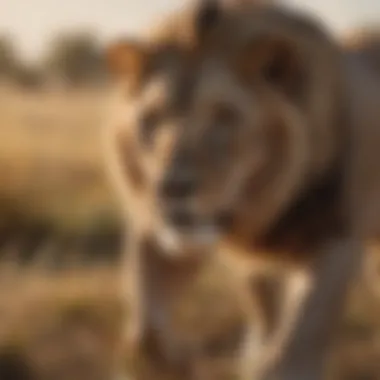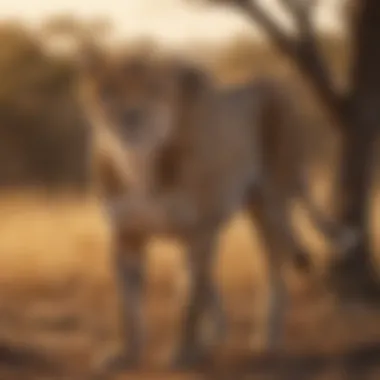Preserving the Endangered Species of the Savanna: A Call to Action


Animal Species Profile
As we delve into the realm of endangered species in the unforgiving savanna biome, we encounter a diverse array of fascinating creatures struggling to survive in the face of relentless challenges. Among these remarkable animals is the majestic African lion, known for its awe-inspiring presence and unparalleled charisma. Physically, these apex predators boast a lean, muscular build, a luscious golden coat speckled with black markings, and a distinctive mane framing their regal faces. Roaming the vast savanna grasslands of Africa, these social felines exhibit hierarchical behavior within their prides, forming strong bonds through mutual grooming, communal hunting, and nurturing their young.
Conservation & Wildlife Efforts
The conservation status of African lions is alarmingly precarious, with populations dwindling rapidly due to habitat loss, human-wildlife conflict, and poaching activities driven by illegal wildlife trade. To combat these threats, various conservation initiatives and organizations have been tirelessly working to safeguard the future of these iconic big cats. Success stories stemming from coordinated conservation efforts include the establishment of protected areas, community-based conservation projects, and anti-poaching measures, all contributing to the preservation of lion populations and their ecosystems.
Animal Behavior & Psychology
Beyond their physical prowess, African lions exhibit complex communication patterns using vocalizations, body gestures, and facial expressions to convey dominance, submission, or warnings within their pride structure. Reproductively, lionesses engage in synchronized estrous cycles and shared caregiving responsibilities for their cubs, ensuring their survival in the harsh savanna environment. These apex predators also demonstrate high cognitive abilities, enabling strategic hunting tactics, problem-solving skills, and social perceptiveness vital for thriving in their competitive ecosystem.
Unique Facts & Trivia
Amid the savanna's vast expanse, African lions conceal surprising facts and behaviors that captivate the imagination. Little-known to many, lions are primarily nocturnal hunters, utilizing stealth and coordination to ambush prey under the cover of darkness. Their nomadic nature allows them to adapt to diverse habitats, showcasing their resilience and versatility as top predators in the savanna food chain. Fun trivia includes the intriguing phenomenon of coalition formation among male lions to defend territories, challenge rivals, and increase mating opportunities, highlighting the intricate dynamics of lion social structures.
Pet Care & Tips
While African lions are unsuitable for domestication or pet ownership due to their inherent wild nature and specialized dietary and environmental requirements, individuals can support lion conservation through various avenues. Engaging in responsible tourism practices, supporting ethical wildlife sanctuaries, and spreading awareness about lion conservation challenges are impactful ways to contribute to the protection of these regal creatures and their vanishing savanna habitat.
Introduction
In the vast expanse of the savanna biome, a critical issue looms large – the plight of endangered species. This article delves deep into the challenges faced by these vulnerable animals, shedding light on the urgent need for conservation efforts to safeguard their dwindling populations. The savanna biome is not just a geographic location but a delicate ecosystem teeming with diverse flora and fauna that face imminent threats to their survival.
Overview of the Savanna Biome


The savanna biome, characterized by a blend of grasslands and scattered trees, is a crucial ecosystem that plays a fundamental role in the balance of nature. Spanning vast areas across continents, the savanna biome is home to a myriad of species unique to its habitat. Its distinctive landscape is shaped by seasonal rainfall patterns, which not only influence the vegetation but also dictate the life cycles of the resident fauna. In this dynamic environment, adaptation is the key to survival, and each species has evolved intricate mechanisms to thrive in this challenging terrain.
Significance of Savanna Ecosystem
The savanna ecosystem acts as a vital link in the global ecological chain, contributing significantly to biodiversity and environmental stability. Its wide-ranging impact extends to climate regulation, carbon sequestration, and even water conservation. The diverse array of plants and animals in the savanna biome form intricate relationships, creating a delicate web of interdependence. These interactions not only sustain life within the savanna but also have far-reaching effects on adjacent ecosystems and beyond. Hence, preserving the integrity of the savanna ecosystem is paramount for the overall health of the planet.
Introduction to Endangered Species
Amidst the breathtaking beauty of the savanna biome lie the somber realities faced by endangered species. From majestic African elephants to the stealthy cheetahs, each animal grapples with a unique set of challenges threatening their existence. Habitat degradation, poaching, and climate change loom large as ominous threats to these vulnerable species. The introduction of endangered species in the savanna biome unveils a narrative of resilience and peril, underscoring the urgent need for concerted conservation efforts to ensure their survival.
Threats to Endangered Species
I UnderstandSection Rationale: In the realm of endangered species in the savannas, it becomes imperative to articulate the significant threats jeopardizing the survival of these vulnerable animals. By delineating the various culprits causing harm, this section aims to shed light on the critical importance of understanding and addressing these threats promptly.Elements of Importance: The discussion on threats to endangered species is a pivotal component of this article as it unravels the intricate web of challenges that hover over the existence of fauna in the savanna biome. By exploring the specific threats faced by these vulnerable creatures like habitat loss, fragmentation, poaching, illegal wildlife trade, and the impact of climate change, readers gain a profound understanding of the multifaceted dangers that loom over the fragile ecosystem.Benefits of Exploration: Delving into the threats faced by endangered species not only educates readers about the dire circumstances these animals endure but also serves as a clarion call for action. By dissecting these perils, the article catalyzes awareness and emphasizes the pressing need for conservation initiatives to safeguard the biodiversity of the savannas. Contrary to the often overlooked challenges, this section amplifies the urgency of immediate intervention and concerted efforts to mitigate the looming threat to endangered species.
Case Studies of Endangered Species
In the realm of endangered species within the savanna biome, conducting case studies plays a pivotal role in understanding the unique challenges these vulnerable animals face. By delving deep into specifics, such as the African Elephants, Lions, and Cheetahs, researchers can extract valuable insights that aid conservation efforts and enhance species protection strategies. Case studies provide in-depth analysis and documentation of the threats, conservation initiatives, and key characteristics of each species, enabling a comprehensive overview of their status within the savanna ecosystem.
African Elephants
Unique Characteristics
Considering the African Elephants, their unique characteristics hold immense significance in the realm of biodiversity conservation. The sheer size and iconic tusks of these majestic creatures not only define their physical presence but also symbolize their importance in the ecosystem. The elephants' ability to forge strong social bonds and their remarkable memory capabilities are standout features that contribute to their survival tactics. Despite their immense strength, elephants face the dire threat of poaching due to the high demand for ivory, placing their existence at great risk within the savanna habitat.
Threats Faced
The African Elephants encounter a myriad of threats that jeopardize their population sustainability. Rampant poaching fueled by the illegal wildlife trade continues to decimate elephant numbers, disrupting the delicate balance of the savanna ecosystem. Additionally, habitat loss and human-wildlife conflicts pose significant challenges to their survival, further exacerbating the precarious situation faced by these gentle giants. Conservation efforts must intensify to combat these threats and secure the future of the African Elephants in their natural habitat.


Conservation Efforts
To safeguard the African Elephants from extinction, robust conservation efforts are imperative. Deploying anti-poaching units, implementing stricter laws to curb illegal wildlife trade, and establishing protected areas are crucial steps in preserving elephant populations. Engaging local communities in conservation initiatives and promoting ecotourism projects that benefit both wildlife and humans are integral strategies to foster coexistence and ensure the long-term survival of these remarkable creatures.
Lions
Habitat and Behavior
Examining the intricate dynamics of Lions in the savanna biome reveals the intimate relationship between their habitat and behavior. Lions' adaptability to a variety of landscapes, from grasslands to semi-deserts, underscores their resilience in diverse environmental conditions. Their social structure, characterized by pride dynamics and cooperative hunting strategies, showcases the sophistication of lion behavior. Understanding these intricate connections between habitat and behavior is paramount for the effective conservation of Lions in the savanna.
Challenges to Survival
Lions face formidable challenges to their survival, ranging from habitat degradation to human-wildlife conflicts. Rapid urbanization encroaches upon lion territories, leading to a reduction in suitable habitats and fragmentation of populations. Furthermore, retaliatory killings by farmers and poaching for trophy hunting present pressing threats to lion populations. Addressing these challenges demands robust conservation measures that prioritize habitat restoration, conflict mitigation, and community engagement to ensure the persistence of Lions in the savanna.
Protection Strategies
Formulating comprehensive protection strategies is essential in securing the future of Lions within the savanna biome. Implementing conservation policies that safeguard lion habitats, establishing wildlife corridors to enable genetic exchange, and promoting sustainable coexistence with local communities are critical steps in lion conservation. Educating the public about the importance of preserving apex predators like Lions and supporting ecotourism initiatives that benefit both wildlife and communities are integral components of protection strategies aimed at enhancing lion conservation efforts.
Cheetahs
Population Decline Factors
Exploring the factors contributing to the population decline of Cheetahs sheds light on the unique challenges this species faces in the savanna environment. Habitat loss, human-wildlife conflicts, and genetic bottlenecks pose significant obstacles to cheetah populations, resulting in dwindling numbers across their range. The loss of prey base due to human activities and competition with other predators further threatens the survival of cheetahs, emphasizing the urgency of conservation interventions to stabilize their populations.
Conservation Initiatives


Implementing targeted conservation initiatives is crucial in reversing the downward trend of Cheetah populations in the savanna. Collaborative efforts among conservation organizations, research institutions, and governmental bodies are essential to address the multifaceted challenges faced by cheetahs. Conservation initiatives such as habitat restoration, captive breeding programs, and community-based conservation projects play a vital role in mitigating threats and creating conducive environments for cheetahs to thrive. By fostering partnerships and investing in innovative conservation strategies, it is possible to secure a future where cheetahs coexist harmoniously with other wildlife in the savanna landscape.
Conservation Efforts
In the challenging landscape of the savanna biome, implementing robust conservation efforts is paramount to safeguarding its endangered species. Conservation efforts play a pivotal role in mitigating the threats faced by vulnerable animals, ensuring their survival for future generations. The multifaceted nature of conservation efforts encompasses a diverse range of strategies, including habitat protection, anti-poaching measures, community engagement, research initiatives, and monitoring programs. By focusing on conservation efforts, this article sheds light on the proactive steps essential for preserving the delicate balance of the savanna ecosystem and protecting its unique wildlife.
Protected Areas and Reserves
Protected areas and reserves are vital components of conservation strategies aimed at safeguarding the biodiversity of the savanna biome. These designated areas serve as sanctuaries for endangered species, providing secure habitats where wildlife can thrive free from human-induced threats. The establishment of protected areas and reserves not only ensures the physical protection of flora and fauna but also fosters ecological resilience and promotes genetic diversity within animal populations. Through stringent enforcement of regulations and continuous monitoring, these designated areas act as crucial strongholds for preserving the rich tapestry of life in the savanna.
Community Involvement in Wildlife Conservation
Community involvement is a cornerstone of successful wildlife conservation efforts in the savanna biome. Engaging local communities in conservation initiatives fosters a sense of stewardship and promotes sustainable coexistence between communities and wildlife. By empowering communities through education, employment opportunities, and capacity-building programs, conservationists can harness local knowledge and resources to combat illegal activities like poaching and deforestation. Collaborative partnerships between conservation organizations and communities not only enhance conservation efficacy but also foster a sense of collective responsibility towards protecting the savanna's endangered species.
Research and Monitoring Programs
Research and monitoring programs constitute essential tools for evaluating the effectiveness of conservation efforts in the savanna biome. Through scientific research, conservationists can gain valuable insights into species behavior, habitat utilization, population dynamics, and the impact of human activities on wildlife. By implementing rigorous monitoring programs, conservationists can track species populations, identify emerging threats, and adapt conservation strategies accordingly. The data gathered from research and monitoring programs serve as a foundation for evidence-based decision-making, allowing conservationists to implement targeted interventions that yield positive outcomes for the protection of endangered species in the savanna.
Future Prospects and Challenges
In the realm of savanna conservation, the focus shifts towards Future Prospects and Challenges with a meticulous outlook. Ecosystems in the wild face a multitude of hurdles and shining a spotlight on these impending challenges is paramount. With a lens directed towards the future, understanding the complexities of conservation aims at paving the way for a sustainable coexistence between mankind and wildlife. Future Prospects entail a vision of harmonious interaction between humans and the diverse species that call the savanna home. The Challenges, on the other hand, loom large, encompassing issues such as habitat degradation, climate change impact, and human-wildlife conflicts. Realizing a stable future requires not only intent but meticulous planning and actionable measures. By acknowledging these challenges head-on, it sets the stage for proactive endeavors aimed at safeguarding the biodiversity richness inherent in the savanna ecosystem. The discussion of Future Prospects and Challenges initiates a dialogue for a conscientious conservation approach, fostering a deeper understanding of the intricate balance required to preserve these vital ecosystems.
Sustainable Conservation Practices
Embedded within the fabric of savanna conservation lies the essence of Sustainable Conservation Practices, an imperative component ensuring the longevity of endangered species. Embracing sustainability is not merely an option but a necessity in the preservation efforts to safeguard the unique flora and fauna of the savanna. These practices are rooted in the idea of mitigating human impact while fostering a symbiotic relationship between wildlife and their habitats. Methods include habitat restoration, community engagement, and ecological monitoring to track progress and adapt strategies accordingly. Sustainable Conservation Practices underscore a holistic approach that extends beyond present initiatives to guarantee sustained protection for generations to come. Incorporating innovative approaches and technological advancements, conservationists strive to strike a fragile balance between human needs and wildlife preservation. Through the implementation of sustainable practices, the conservation landscape in the savanna evolves towards a more resilient and adaptive model, ensuring the perpetuation of endangered species amidst the dynamic challenges posed by a rapidly changing environment.
Conclusion
In the realm of savanna biodiversity, the conclusion serves as a pivotal point in this expedition into the challenges faced by endangered species. The significance of the conclusion lies in synthesizing the intricate details and profound observations discussed throughout this discourse. It provides a roadmap, guiding us towards a deeper understanding of the urgent need for wildlife conservation in savanna ecosystems. By drawing essential connections between the plight of endangered species and the broader environmental context, the conclusion acts as a beacon of hope for the survival of these vulnerable creatures. It compels us to reflect on our responsibilities as stewards of nature and underscores the critical role each individual plays in securing a sustainable future for savanna species.
Call to Action for Protecting Savanna Species
As we stand at the crossroads of environmental stewardship, a compelling call to action resonates for the protection of savanna species. Embracing this clarion call entails active participation and unwavering commitment to conserving the biodiversity that graces the vast savanna landscapes. Advocating for the safeguarding of these iconic animals requires a collective effort from wildlife enthusiasts, conservationists, policymakers, and the broader community. By promoting awareness, supporting conservation initiatives, and encouraging sustainable practices, we can ensure a harmonious coexistence between humans and wildlife in the savanna. Every individual action, no matter how small, reverberates across the ecosystem, forging a path towards a brighter, more sustainable future for endangered species in the savanna.







